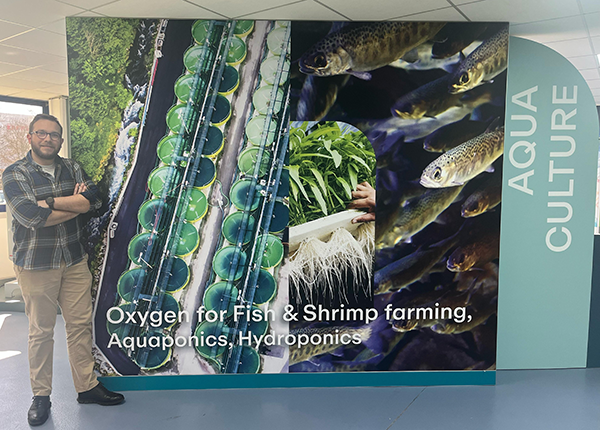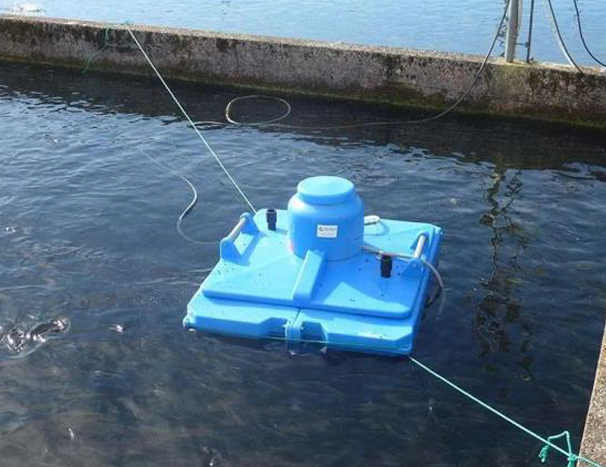
Georges Hetzel, Aquaculture & Water Treatment specialist for the NOVAIR Group
Effective oxygenation is crucial in aquaculture to maintain optimal water quality and fish health. There are several methods and equipment for dissolving oxygen in fish tanks, each tailored to specific operational conditions and needs.
Oxygen injection methods
Oxygen can be supplied to aquaculture ponds by two main methods:
- Direct injection into basins: This method does not require any water flow or lifting height.
- Injection into the fresh water flow: This method requires a water flow and a certain pressure (lift height).
Each method uses specialized equipment to achieve effective oxygenation:
Direct injection into the basins:
- Ceramic diffusers
- Oxygenators
Injection into the new water flow:
- Oxygen cones
- Low Head Oxygenators
- Venturi
- Nano-bubbles
Ceramic diffusers
Oxygen diffusers are usually made of ceramic and generate fine bubbles of oxygen in the water. This is a passive technique, as it does not require pumping or water flow to deliver oxygen to the pool, but only oxygen at sufficient pressure. Ceramic diffusers are generally designed to maintain a dissolved oxygen level in pool water above 70%.
- Benefits: Simple and effective for emergency oxygenation during power outages, pump maintenance or harvests.
- Limitations: Limited dissolution efficiency in shallow water columns, typically 20-30% for a depth of 1 meter.
- Use: Emergency oxygenation during electrical shutdown, pump maintenance or harvesting.
Oxygenators


Oxygenators are devices placed directly in the pools to oxygenate the water. These devices work without the pool needing a flow of new water at a particular pressure. However, their operation requires a power supply in addition to that of oxygen. Oxygenators can be floating or fixed devices. In both cases, they operate via a propeller system to create a flow of water inside the oxygenator. The oxygen is sucked in through a tube, forming fine bubbles that dissolve in the water. The dissolution efficiency is generally between 70% and 80%. Oxygenators generally aim to maintain a dissolved oxygen level in the pool water above 70%.
- Advantage: Oxygenators have a good dissolution efficiency and their use does not require any special infrastructure.
- Limit: Power failure shutdown
- Applications: Ideal for ponds with limited fresh water flow and long rectangular ponds (such as “Racewas”) where oxygen levels drop at the end.Cônes à oxygène
Oxygen cones are conical-shaped pressurized systems. They are primarily made of reinforced fiberglass, although other materials can be used.
Water is pumped into the upper, narrow part of the cone, at a pressure generally between 1.5 and 2.0 bars. At the same time, oxygen is injected into this same section, at a pressure slightly higher than that of the water. This double flow – water and oxygen – then progresses towards the widened base of the cone.
As the width of the cone increases, the flow speed gradually decreases. This slowdown allows the oxygen bubbles to remain suspended in the water until they are completely dissolved, thus optimizing the oxygenation of the environment. Also, the higher water pressure in the cone makes it possible to reach levels of supersaturation of the water in significant oxygen of the order of 300% for an oxygenation efficiency of 90-95%.
- Advantage: Good oxygen dissolution efficiency and high supersaturation.
- Limitation: the operation of the cones requires significant pressure and therefore high pump energy.
- Application: Dissolution of large quantities of oxygen in low water flow rates at medium to high pressures.
Jet platforms
Jet platforms are used to efficiently achieve high levels of oxygen in a water flow. Their principle is based on injecting oxygen under a perforated plate, generating a layer of oxygen in a water/oxygen contact chamber located under this plate. In normal operation, the water accumulates above the perforated plate before passing through the nozzles, thus falling into the contact chamber. This is where the oxygen dissolves in the water. A water height difference of approximately 1 to 1.5 meters (i.e. a pressure of 0.1 to 0.15 bar) is required between the water level above the perforated plate and that at the jet platform outlet. Despite this low pressure, this system can achieve an oxygen supersaturation of approximately 180 to 200%, with an oxygenation efficiency of around 80% - 85%.
- Advantage: Can achieve significant supersaturation at low pressure.
- Limit: requires a water flow and therefore often the operation of pumps
- Application: Oxygenation of low to high water flows with an average height difference.
Venturi
Venturi systems on a hydrodynamic cavitation principle. Water is pumped through a narrow pipe section, which increases the speed of the water flow and reduces the absolute pressure creating a vacuum. Oxygen is introduced through an orifice at this level and is sucked into the water flow due to the vacuum. The oxygen then mixes with the water where it dissolves in it, this is called the venturi effect. This system usually operates with a water pressure of 1 bar and allows an oxygen supersaturation of 120-180% and an oxygenation efficiency of 80%-90% to be achieved.
- Advantage: These systems are generally relatively inexpensive and can easily be integrated into a piping network.
- Disadvantage: Requires relatively high pressure for average oxygenation efficiency
- Application: When space or pressure available is not sufficient for an oxygen cone.
Nano-bubbles
Like Venturi systems, nanobubble systems use the principle of hydrodynamic cavitation to inject oxygen into a water flow. The main difference is that with nanobubbles, some of the oxygen dissolves in the water, while some remains in gaseous form, in the form of nanobubbles.
Measuring less than 200 nanometers in diameter (about 2,500 times smaller than a grain of salt), nanobubbles have an exceptionally large surface area in contact with water. Their tiny size gives them high stability, neutral buoyancy and extremely efficient gas transfer.
This technology allows to achieve an oxygen supersaturation of 200 to 300%, while keeping the nano-bubbles suspended in the water. These bubbles act as a reserve of undissolved oxygen, ready to gradually dissolve when the supersaturation decreases.
Despite impressive performance, with dissolution rates of 90 to 95%, this technology remains in the development phase. To date, its large-scale application remains limited, although it has strong potential for the future.
- Advantage: This technology offers very good oxygenation efficiency with limited energy consumption.
- Disadvantage: Proven technology but still under development.
- Application: Installation in the water flow of new installations or in parallel for existing installations.
Conclusion
Choosing the right oxygen dissolving method or equipment depends on the specific needs of your aquaculture operation. Factors such as water flow, pressure, tank design, and oxygen demand play a critical role in determining the best solution. By choosing the right system, you can ensure optimal oxygen levels for healthy and sustainable aquaculture production.

